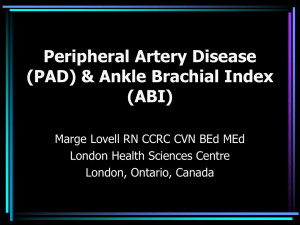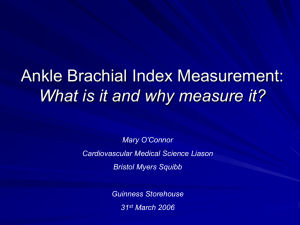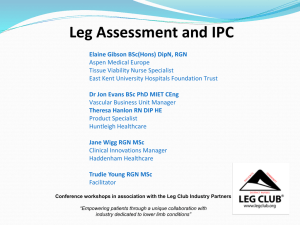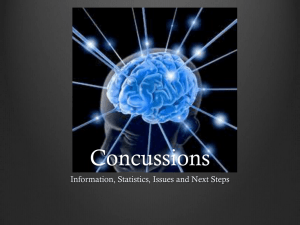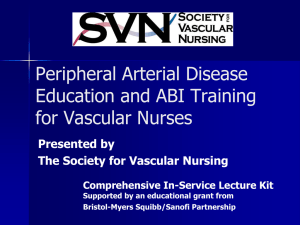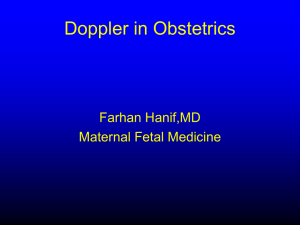NISCHR AHSC Presentations
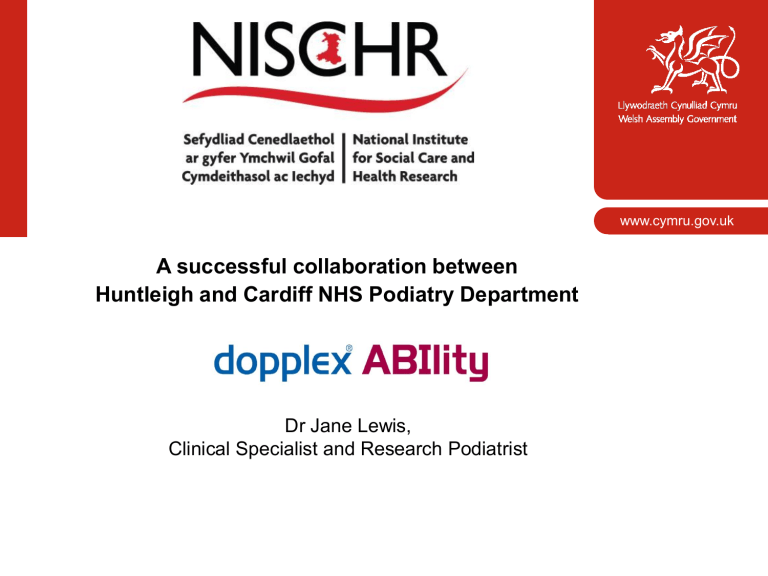
A successful collaboration between
Huntleigh and Cardiff NHS Podiatry Department www.cymru.gov.uk
Dr Jane Lewis,
Clinical Specialist and Research Podiatrist
The Diagnostic Products Division of Huntleigh has over 25 years experience in design, development, manufacturing and marketing non-invasive electro-diagnostic products to the global medical market
Award winning innovators in medical technology
– 1982, 1987, 1992 Queen’s Award for Export (Medical Systems)
– 1993 Queen’s Award for Technological Achievement (Doppler range)
– 2003 Queen’s Award for Innovation (Vascular Assist range)
– 2009 MediWales NHS Partnership with Academia and Industry Award
(Ability)
– 2010 IET Innovation Award – Highly Commended (Ability)
Long standing relationship working with the NHS
Globally established training programmes in Peripheral Arterial
Disease
Peripheral Arterial Disease
In Europe and North America an estimated 27 million people have
Peripheral Arterial Disease (PAD) and in the UK around 100,000 people are diagnosed every year.
PAD patients 6x more likely to die from Coronary Heart Disease
(CHD)
(Belch et al, 2007, Br J Diabetes Vasc Dis 7(5): 236-239)
In 2012, estimated that 17% of pop (102m) will be > 65 and at high risk of leg/foot ulcers
Approximately 20% of population > 65 are asymptomatic PAD
Inadequate primary care vascular assessments
Up to 33% inappropriate referrals to Vascular Team (back pain, neurological pain, nerve entrapment)
Detection of PAD is paramount and potentially treatable
Large body of evidence supporting the efficacy of Ankle Brachial
Index (ABI) as an effective diagnostic and risk assessment tool
(Newman, 1999: Papamicheal, 2000: Sikkink, 1997: Zheng, 1997)
To date, ABI is the most effective, accurate and practical method of PAD detection
(Belch et al, 2003)
ABI < 0.9 is 95% sensitive in detecting angiogram positive disease and almost 100% specific in excluding healthy individuals
ABI < 0.9 is highly predictive of morbidity and mortality from cardiovascular events linked with PAD (Belch et al, 2003)
ABI also provides information regarding severity of PAD that can assist in guiding a treatment approach
Early Collaboration
In 2002, Huntleigh had previously supported Jane Lewis in her PhD research, funded by the WAG.
This work used the Vascular Assist for detecting PAD in diabetic patients using ABI, toe pressures and Pulse Volume Recordings
(PVR).
It concluded that:
advancements in ABI measurements are needed
PVR had clinical value in assessing diabetic patients with calcified arteries.
Vascular
Assist
Aim of the New Development
In 2008, Huntleigh decided to develop a device that would quickly and easily measure the ABI, not based on the Doppler technique.
The new device should:
be automatic and easy to use
portable
require minimal training
be clinically reliable
have quantifiable results
eliminate the need to rest the patient
allow early identification of PAD and intervention
Two Chamber Cuffs
An innovative two chamber cuff was designed to detect systolic pressures based on PVR technology
Dr Jon
Evans
Coinventors
Dr Nigel
Gough
The Ability Prototype Unit
Developed a laptop based prototype
Birth of
Automatic A nkle B rachial I ndex
System
Tried on volunteers
Needed to be clinically tested
Cuff design improvements
Consulted Cardiff Podiatry
Department
Purpose of the study
Clinical Performance
Study
To evaluate the efficacy of the Ability unit for its agreement and time taken to conduct the test when compared with the current gold standard Doppler method for obtaining ABIs
Clinical involvement essential
Regular brainstorming meetings
Is study design practical/achievable?
Is patient target group realistic?
How easy will it be to recruit patients?
Is inclusion/exclusion criteria too tight?
Measurable study outcomes were agreed.
Clinical Performance
Study
Utilised existing Podiatry vascular assessment clinics
Few patients attending were found to be unsuitable for study
Sequence
A
Ability unrested
(timed)
Sequence
B
10 mins rest
10 mins rest
Ability rested
(timed)
5 mins rest
Doppler rested
(timed)
5 mins rest
Doppler rested
(timed)
Ability rested
(timed)
The Ability Prototype Unit and
Doppler in Use
Vascular
Assist
Ability data collection device – clinician blinded to the data collected
Results
Agreement of Unrested Ability and Rested Doppler
Bias = –0.064
95% limit of agreement = ± 0.22
Objective achieved: Agrees with
Doppler
Results
Agreement of Unrested and Rested Ability
Bias = –0.026
95% limit of agreement = ± 0.21
Objective achieved: No rest required
Results
Test Timings
Mean time
Ability
Unrested
7.1 min
Doppler
Rested
31.5 min
Summary of
Clinical Study
Good agreement between Doppler and Ability
The Ability measurement takes significantly less time than
Doppler and obviates the need for a rested patient by the simultaneous cuff inflation improving the whole patient experience
The Ability has the potential to be used as a screening tool for
PAD in primary care settings by increasing the patient throughput and its simplicity allows it to be operated by a Healthcare
Support Worker.
Allows earlier diagnosis and intervention for lifestyle changes and risk factors
Study provided clinical evidence that the innovative technique worked
Collaboration with the Concept
Design
Local market research amongst potential users was undertaken to develop the correct concept design and its accessories.
Automatic A nkle B rachial I ndex
System
136
138
146
84
1.06
normal
ABI
0.61
moderate
PVR printout
Automatic A nkle B rachial I ndex
Two chamber cuffs are connected to the Ability unit
Collaboration with the Design of
Accessories
Developing the carry bag and trolley
Evaluating the Disposable Sleeves
Disposable sleeves
For improved infection control
Eliminates the need to clean cuffs
Fits ankles and arms
Portability
Community
Clinic
Home visits
Hospital Clinic
Advantages of Local
Collaboration
Regular succinct brainstorming meetings for:
planning
problem solving
quick resolution of technical problems
improving usability of the product
reviewing risk analysis
provided clinical input at many stages of the project
Allowed for smooth running of study and more efficient data collection.
Future Collaboration
Primary Care study with GP’s
To reduce the number of referrals to secondary care
To indentify the use of Ability as a cost effective assessment tool
Funding opportunities are being sought
Masters in Research (MRes) – PVR study
Improve the identification of PVR waveforms
How they correlate with the Doppler waveforms
Secondary Care study – ABI and TBI vs Duplex scan
How well ABI and TBI PAD diagnosis compares with Duplex scans
Development of the large cuff design
